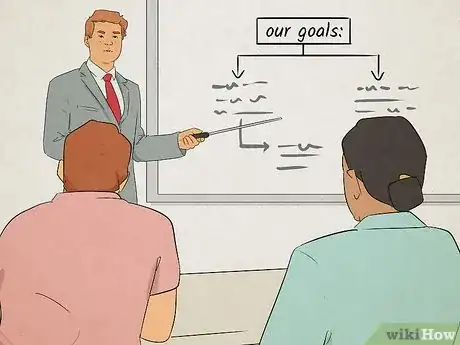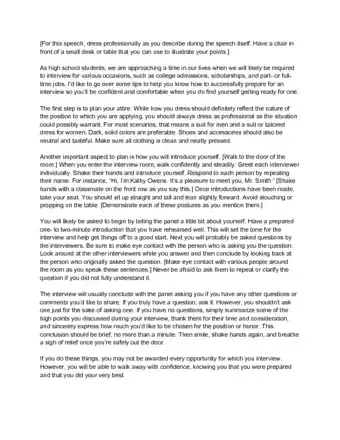This article was co-authored by Archana Ramamoorthy, MS. Archana Ramamoorthy is the Chief Technology Officer, North America at Workday She is a product ninja, security advocate, and on a quest to enable more inclusion in the tech industry. Archana received her BS from SRM University and MS from Duke University and has been working in product management for over 8 years.
There are 12 references cited in this article, which can be found at the bottom of the page.
This article has been viewed 143,707 times.
Effective leadership is an important skill in the professional arena. A skilled leader is a strong communicator, motivator and problem solver. Building teams, motivating employees, assessing client needs and managing conflicts are some of skills a good leader provides. Learning these skills, however, is a life-long process.
Steps
Building Leadership Skills
-
1Take leadership courses. Leadership courses offer intensive training in skills like project management, collaborative problem-solving, and critical thinking. These are skills indispensable to any workplace and can help you move up in your company faster. Some leadership courses are available as online certifications, however you can take leadership courses through a local college.[1]
-
2Seek help and ask questions. If you are faced with a new challenge, ask a senior coworker how they would begin the project. If you run into an unexpected problem, reach out to a manager for assistance and trouble shooting.[2]
- Leverage other people's experience to complete tasks effectively and efficiently. The next time you encounter the same problem, you'll be prepared to tackle it independently.
- People will respect you for asking, valuing their opinion, and offering assistance more frequently.
Advertisement -
3Hone communication skills. Not everyone is a natural public speaker, but there are ways to overcome stage-fright, along with other pitfalls of public speaking.
- Join Toastmasters.Toastmasters is an international organization devoted to helping people become better, more comfortable public speakers. Many businesses support an internal chapter and encourage their employees to join, but you can find Toastmasters clubs in nearly any community.[3]
- Learn how to speak without filler words. "Uhm," "like," and "uhhhh" are just a few examples of filler words that creep into everyday speech. These words can distract listeners from the message we are trying to present and may even make the speaker seem unprepared or lacking in knowledge.
Demonstrating Leadership in the Workplace
-
1Have a positive mental attitude. Being positive allows you to take full advantage of opportunities when they occur. It also greatly assists with establishing a social network in your workplace. Below are some helpful tips for maintaining a positive mental attitude:
- Remember that you are capable and qualified for the job. You would not have been hired if you did not possess all the qualities the job requires.
- Say "yes" to challenges and new experiences. Undertaking challenges and succeeding builds confidence and can positively influence coworkers and supervisors.
- Remember that you are in control of how you think and feel. Negativity exists within each of us, but everyone has a choice whether to foster it. When negative feelings creep in, actively remember the things you have to feel grateful for, pushing negative thoughts to the back of your mind.
- Spend time with positive people. It's much easier to be negative when talking to other negative people. Choose to spend time with people who are upbeat and committed to positive thinking.
- Find reasons to smile. It's easier to think positive thoughts when we surround ourselves with objects and mementos that bring joy and laughter.
-
2Be proactive. Being proactive means taking responsibility for your actions and the tasks assigned to you. It also means refusing to worry about things you can't control and focusing your time and effort on the parts of a problem that you can change.[4] . Below are some suggestions for how to be more proactive at work:[5]
- Be solution-focused. It's easy to get hung up on details and blame sharing, but real leaders focus on the task at hand and what is required to complete it.
- Demonstrate accountability for your work. If you make a mistake, own it. If you have an idea, pitch it. Don't be demoralized if people don't always agree with you. By speaking up and contributing, you are demonstrating engagement and concern, both important leadership qualities.
- Be consistent and dependable. Treat all coworkers with the same degree of professionalism and respect. Show up to work on time, prepared and ready to contribute. When tasks are due, complete them within deadlines or ahead of schedule.
- Offer honest communication. While it is never a good idea to bring personal matters into the workplaces, being honest and open about problem-solving and task completion is an important part of leadership. For example, if you are lacking the tools or resources to complete an assigned task, speak to your manager sooner rather than later about what you need or how to create a work around.
-
3Engage in active listening. Not only does this demonstrate respect and attention to the person talking to you but it helps you. Below are tactics for active listening:[6]
- Restate information: Demonstrates listening and also gives you the ability to clarify things you are less certain of.
- Offer subtle "encouragers": Nod you head. Say "uh huh" or "I see" to encourage the person talking to continue and elaborate on their ideas.
- Give feedback: This allows you to collaborate with the speaker and even nuance the information that is being offered.
- Probe for more information: Ask questions to draw out elaboration on points that are important.
- Validation: Tell the person you are talking to that you appreciate them taking the time to offer their thoughts.
- Summarize: Summarizing information into your own words permits you to take personal ownership of the information, increasing learning.
-
4Be a role model. Role models are people we look up to, who model behaviors we seek to emulate. Some ways to be a role model are:[7]
- Show confidence. Take on new challenges. Be positive. Show others that you are not afraid of new roles or projects.
- Be unique. Don't try to be like everyone else. Be proud of who you are and the ways that your unique talents are create value-add moments in your work.
- Communicate with everyone: This doesn't just mean talking. Part of good communication is listening to the concerns of others.
- Show respect and concern: People notice when you use others to get ahead. It's important to demonstrate that you care about your team and their success as a group.
- Be humble. This doesn't mean that you should hide your accomplishments; however, showing humility makes it easier to admit mistakes when you (inevitably) make them and encourages others to help you.
- Do good things outside of work: Commitment to worth causes reflects well on your ability to commit to a company.
Managing your Team
-
1Focus on the goals of the organization. Understand the vision of the business or project and keep it at the forefront at all times. Prioritize the success of the organization over personal interests in advancement. Below are some steps to achieving goal alignment:
- Set goals that reflect company values and objectives. Every company has a masthead statement reflecting what the company stands for and hopes to achieve through it's efforts. Before assigning tasks, make sure you are familiar with these core objectives and ensure that employees are aware how their own efforts align with company values.
- Communication expectations to employees. It is often a good idea to put verbal directions in writing and check in with employees periodically to make sure they understand the task.
- Document progress. This can often be automated through a database or tracker; however, it can also be done through email memos or a spreadsheet.
- Offer feedback on deliverables. There are various ways this can be accomplished. Informally, you can communication through instant messaging; emails are good if you need to attach documentation for records or printing. Finally, if the deliverable is a major project, feedback can come in the form of a quarterly review, where you meet directly with the employee to review performance.
-
2Organize training sessions. Training may be provided by you, other team members or an outside training consultant. Customize training to the specific needs of workers, focusing on goal alignment between employee objectives and the organizational bottom line.
- It is also a good idea to talk to employees directly about what they would like training on, using this to help guide curriculum needs.
-
3Facilitate meetings. Meetings are important to team success. They are a place to share in formation, collaborate, reach decisions, and align goals. Organize meetings at regular intervals-- every two weeks for a 6 week project, or every 3 months for a year-long initiative--to discuss project details and re-affirm organizational goals.[8]
-
4Coordinate schedules for meetings. Schedule meetings to accommodate availability and realistic limitations. For example, while everyone may be available late-afternoon on a Friday, it may not be the best time to discuss challenging issues.
- If not everyone can make the meeting, assess who the key players are for the project, ensuring the meeting matches their respective schedules.
- Delegate note-taking and ensure the meeting details are disseminated to those who could not attend.[9]
-
5Prepare an agenda. An agenda should, at minimum, set a topic list, delegate presentation duties, and set the time devoted to each agenda item. When typed out, it can be circulated before the meeting in case agenda items need to be added, and can also be used as a checklist during the meeting.
-
6Lead meetings. This means taking steps to ensure all agenda business is resolved and all voices are heard. Below are suggestions to assist with this:[10]
- Establish meeting rules to mediate when individuals monopolize discussions. For example, set and maintain times limits for discussion.
- Open the floor to designated presenters. After presenting information, open discussion for all team members.
- After each agenda item and its corresponding discussion, briefly summarize outcomes and move on.
- After all agenda items have been discussed, confirm and action plan.
- Schedule the next meeting and collect suggested agenda items.
-
7Act decisively. Decisive leadership avoids stagnation and vacillation, keeping workers on task and motivated, while also behaving responsively to change and new information. Below are the features of decisive leadership:
- Clarity of purpose: Ensures alignment of all decisions with organizational goals and ethics.
- Engagement: Allows leaders to live by example, embodying engagement with company values that allows for effective, efficient decision making.
- Transparency: Does not permit self-interest. Instead, demonstrates how decisions for the good of the company help everyone flourish.
- Creating a culture of honest failure: Honest failures are learning points that act as springboards to better decision making. Decisive leadership embraces those times when mistakes are made.
- Open and effective communication: Alignment with company values ensures that, where communicating upward into senior management or down the hierarchy to managed employees, there is no inconsistency or contradiction.
Motivating Employees
-
1Define tasks. Being a leader in the workplace often involves recognizing when workers need greater direction. This is especially important for new employees or those in new positions who are still norming to their role.
- Be sure new employees have training before beginning their new role. Walk the employee through the steps of their new position, providing note-taking materials.
- Ensure the employee handbook is up-to-date and easily accessible to all employees, new and existing alike.
- Delegate instruction and allow new employees to shadow senior coworkers.
-
2Assess employee needs and create growth opportunities. Appeal to the professional interests of each worker by creating clear paths for development and promotion. Motivate workers by challenging them. Many people thrive when challenged to innovate or perform new tasks. Encourage team members to increase efficiency by creating new systems or recommending product changes.[11]
-
3Recognize and appreciate worker effort. When employees perform well, acknowledge their achievements verbally or by setting up rewards systems. Announce these achievements to the rest of the team, offering opportunities for positive reinforcement and role modeling. [12] . Opportunities for recognition can include:
- Completing a unique project that is important to the success of the team.
- Taking a leadership role within a company charity event.
- When an employee has a major life event (i.e. marriage, childbirth, graduation)
- When an employee received a promotion or bonus.
Managing Conflict
-
1Be impartial and listen to understand. When resolving a dispute between others in the workplace, focus on the facts of the situation.
- Avoid making character assessments or personal comments. Management should always be impartial when reviewing employee conflict and avoid personal relationships that can create bias.
- Open a dialogue between the parties involved. Often conflicts arise from miscommunication. Be a mediator and open dialogue between the parties in conflict, helping them come to a constructive conclusion to the issue.
- Be firm but fair. People aren't always going to get along and some personality types clash in collaborative settings. Set down ground rules for employee comportment, but don't act rashly, especially if this is a first time conflict.
-
2Address issues with the appropriate parties. If the conflict is between yourself and an employee, discuss the issues one-on-one. If there is a conflict between the team and management goals, call a team meeting. Avoid confronting and calling out individual team members about sensitive issues in group meetings.
-
3Don’t wait to resolve the issue. Deal with the issue as soon as it comes to your attention. Otherwise, it could escalate and negatively impact employee performance. Just make sure not to address the issue too quickly, before you’ve had time to consider a course of action.
-
4Give constructive criticism. Encouragement and motivation are powerful tools when used correctly.
- Remind individuals of what they did correctly while also criticizing how they reacted poorly.
- Offer criticism that solves problems. Instead of focusing in on what an individual did wrong, ask "How could this have been approached more productively?"
- Be specific and relevant to the point of the discussion. It's easy to get side-tracked, but be sure to keep the discussion focused on a sustainable and positive outcome to the conflict.
-
5Broadcast praise. When conflict happens and resolution occurs, praise teamwork and collaboration and recognize the people who made it happen.
- If the conflict is between two employees, remind both of their strengths and weaknesses and how glad you are that the situation is resolved.
- If the conflict is between the team and management, recognize the key compromisers and team players who achieved resolution via an email memo to the whole team.
When Should I Consult A Leadership Coach?
Leadership Help
Expert Q&A
-
QuestionWhat should every leader know?
 Archana Ramamoorthy, MSArchana Ramamoorthy is the Chief Technology Officer, North America at Workday She is a product ninja, security advocate, and on a quest to enable more inclusion in the tech industry. Archana received her BS from SRM University and MS from Duke University and has been working in product management for over 8 years.
Archana Ramamoorthy, MSArchana Ramamoorthy is the Chief Technology Officer, North America at Workday She is a product ninja, security advocate, and on a quest to enable more inclusion in the tech industry. Archana received her BS from SRM University and MS from Duke University and has been working in product management for over 8 years.
Chief Technology Officer, Workday Volunteering is a great way to boost your leadership skills. Through volunteering, you learn how to work with people you probably haven't worked with before. You have to be able to explain things succinctly to people who don't have the same background or tools as you do. It can really build up your communication skills.
Volunteering is a great way to boost your leadership skills. Through volunteering, you learn how to work with people you probably haven't worked with before. You have to be able to explain things succinctly to people who don't have the same background or tools as you do. It can really build up your communication skills. -
QuestionIs it better to be a leader than a follower?
 Community AnswerIt all depends on your personality and the personalities of the people around you. Some people feel more comfortable in one role than another, or excel at organizing and motivating others.
Community AnswerIt all depends on your personality and the personalities of the people around you. Some people feel more comfortable in one role than another, or excel at organizing and motivating others.
References
- ↑ http://www.amanet.org/training/promotions/six-skills-for-managers-and-leaders.aspx
- ↑ http://www.essentialpersonnelinc.com/2014/10/09/can-self-reliant-seek-help-workplace/
- ↑ https://www.toastmasters.org/
- ↑ https://www.stephencovey.com/7habits/7habits-habit1.php
- ↑ https://businesscollective.com/8-ways-to-become-the-most-proactive-person-you-know/
- ↑ http://psychcentral.com/lib/become-a-better-listener-active-listening/
- ↑ http://www.caycon.com/blog/2010/10/seven-actions-of-a-true-role-model-entrepreneur/
- ↑ http://www.seedsforchange.org.uk/facilitationmeeting
- ↑ https://hbr.org/2011/03/scheduling-a-meeting-the-right
- ↑ https://www.ohrd.wisc.edu/academicleadershipsupport/LeadMeetings/ResponsibilitiesoftheChair/Whattododuringameting/tabid/114/Default.aspx
- ↑ http://www.apaexcellence.org/resources/creatingahealthyworkplace/employeegrowth/
- ↑ http://www.roberthalf.com/employers/hiring-advice/employee-retention/corporate-culture/employee-recognition




















































































